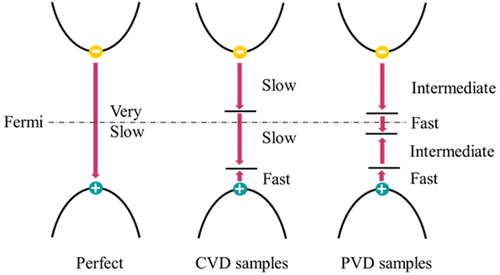当前位置:
X-MOL 学术
›
Nano Lett.
›
论文详情
Our official English website, www.x-mol.net, welcomes your
feedback! (Note: you will need to create a separate account there.)
Why Chemical Vapor Deposition Grown MoS2 Samples Outperform Physical Vapor Deposition Samples: Time-Domain ab Initio Analysis
Nano Letters ( IF 9.6 ) Pub Date : 2018-05-18 00:00:00 , DOI: 10.1021/acs.nanolett.8b01501 Linqiu Li , Run Long 1 , Oleg V. Prezhdo
Nano Letters ( IF 9.6 ) Pub Date : 2018-05-18 00:00:00 , DOI: 10.1021/acs.nanolett.8b01501 Linqiu Li , Run Long 1 , Oleg V. Prezhdo
Affiliation

|
Two-dimensional transition metal dichalcogenides (TMDs) have drawn strong attention due to their unique properties and diverse applications. However, TMD performance depends strongly on material quality and defect morphology. Experiments show that samples grown by chemical vapor deposition (CVD) outperform those obtained by physical vapor deposition (PVD). Experiments also show that CVD samples exhibit vacancy defects, while antisite defects are frequently observed in PVD samples. Our time-domain ab initio study demonstrates that both antisites and vacancies accelerate trapping and nonradiative recombination of charge carriers, but antisites are much more detrimental than vacancies. Antisites create deep traps for both electrons and holes, reducing energy gaps for recombination, while vacancies trap primarily holes. Antisites also perturb band-edge states, creating significant overlap with the trap states. In comparison, vacancy defects overlap much less with the band-edge states. Finally, antisites can create pairs of electron and hole traps close to the Fermi energy, allowing trapping by thermal activation from the ground state and strongly contributing to charge scattering. As a result, antisites accelerate charge recombination by more than a factor of 8, while vacancies enhance the recombination by less than a factor of 2. Our simulations demonstrate a general principle that missing atoms are significantly more benign than misplaced atoms, such as antisites and adatoms. The study rationalizes the existing experimental data, provides theoretical insights into the diverse behavior of different classes of defects, and generates guidelines for defect engineering to achieve high-performance electronic, optoelectronic, and solar-cell devices.
中文翻译:

为什么化学气相沉积生长的MoS 2样品优于物理气相沉积样品:时域从头算分析
二维过渡金属二硫化碳(TMD)由于其独特的性能和多样化的应用而备受关注。但是,TMD性能在很大程度上取决于材料质量和缺陷形态。实验表明,通过化学气相沉积(CVD)生长的样品性能优于通过物理气相沉积(PVD)获得的样品。实验还表明,CVD样品显示出空位缺陷,而在PVD样品中经常观察到反位缺陷。我们的时域从头算研究表明,反位和空位都会加速电荷载流子的捕获和非辐射重组,但反位比空位更有害。反位点会为电子和空穴同时形成深陷阱,从而减小能隙以进行重组,而空位则主要捕获空穴。反位点也会扰乱带状边缘状态,从而与陷阱状态产生明显的重叠。相比之下,空位缺陷与能带边缘状态的重叠要少得多。最后,反位点可以产生接近费米能量的电子陷阱和空穴陷阱对,从而允许通过基态的热激活进行陷阱捕获,并强烈地促进了电荷的散射。结果,反位点将电荷重组加速了8倍以上,而空位使重组率降低了不到2倍。我们的模拟证明了一个普遍的原理,即丢失的原子比放错原子的良性要好得多,例如反位点和原子 该研究合理化了现有的实验数据,提供了对不同类别缺陷的不同行为的理论见解,
更新日期:2018-05-18
中文翻译:

为什么化学气相沉积生长的MoS 2样品优于物理气相沉积样品:时域从头算分析
二维过渡金属二硫化碳(TMD)由于其独特的性能和多样化的应用而备受关注。但是,TMD性能在很大程度上取决于材料质量和缺陷形态。实验表明,通过化学气相沉积(CVD)生长的样品性能优于通过物理气相沉积(PVD)获得的样品。实验还表明,CVD样品显示出空位缺陷,而在PVD样品中经常观察到反位缺陷。我们的时域从头算研究表明,反位和空位都会加速电荷载流子的捕获和非辐射重组,但反位比空位更有害。反位点会为电子和空穴同时形成深陷阱,从而减小能隙以进行重组,而空位则主要捕获空穴。反位点也会扰乱带状边缘状态,从而与陷阱状态产生明显的重叠。相比之下,空位缺陷与能带边缘状态的重叠要少得多。最后,反位点可以产生接近费米能量的电子陷阱和空穴陷阱对,从而允许通过基态的热激活进行陷阱捕获,并强烈地促进了电荷的散射。结果,反位点将电荷重组加速了8倍以上,而空位使重组率降低了不到2倍。我们的模拟证明了一个普遍的原理,即丢失的原子比放错原子的良性要好得多,例如反位点和原子 该研究合理化了现有的实验数据,提供了对不同类别缺陷的不同行为的理论见解,





















































 京公网安备 11010802027423号
京公网安备 11010802027423号